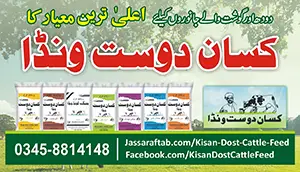
No Lumpy Skin Disease in Punjab, Secretary Livestock declared
Lumpy Skin Disease (LSD) is a contagious viral disease primarily affecting cattle, buffaloes, and wild animals. Secretary Livestock Punjab has declared that there are still no cases of Lumpy Skin Disease in Punjab. Moreover, the Animal Husbandry Commissioner’s Office has issued guidelines for Lumpy Skin Disease Control and LSD Sampling. Lumpy Skin Disease Symptoms, Lumpy Skin Disease Diagnosis, Lumpy Skin Disease Transmission, public health concern and other aspects have been highlighted along with the action plan. It has no public health concern.
The disease causes severe economic losses due to decreased milk production, poor body condition, abortions, temporary or permanent infertility, and damage to hides. The causative agent is the Lumpy Skin Disease Virus (LSDV), classified under the genus Capripoxvirus and the family Poxviridae. LSD has emerged as a widespread epidemic across Asia, Africa, and Europe. The disease is mainly spread by arthropod vectors like mosquitoes, biting flies, and ticks, making it a significant concern for livestock farmers and animal health authorities. Lumpy Skin Disease Symptoms Control is highly important for national food security and national economy.
No Lumpy Skin Disease in Punjab
The Secretary of Livestock Punjab, in a high-level meeting, has declared that there is no LSD in Punjab. He stated in a high-level meeting on Lumpy Skin Disease Symptoms Control and current status. The department has taken measures, and we will not spread the disease. Field force is in action, and interprovincial checkpoints are monitoring the animal movement.
AHC Office Guidelines for Lumpy Skin Disease Control
Animal Husbandry Commissioner’s Office has issued guidelines for Lumpy Skin Disease Control Covering the following aspects
Lumpy Skin Disease Symptoms
The Lumpy Skin Disease Symptoms typically appear within a few days of infection and include high fever (often exceeding 41°C) and the sudden development of cutaneous nodules measuring 2–5 cm in diameter. These nodules are found on the head, neck, limbs, udder, genitalia, and perineum. Over time, some nodules may become necrotic and fibrotic, persisting as hard “sitfasts” or healing with permanent scarring. Affected animals may exhibit enlarged lymph nodes, swelling of the limbs and ventral body parts, and mucosal ulcers in the mouth, digestive, and respiratory tracts.
Additional Lumpy Skin Disease symptoms include myiasis of nodules, conjunctivitis, rhinitis, excessive salivation, depression, anorexia, and weight loss. Infected bulls may experience infertility, while pregnant cows may abort or enter prolonged anoestrus.
Transmission LSD
LSD is primarily transmitted through blood-feeding vectors such as mosquitoes (Culex mirificens, Aedes natrionus), biting flies (Stomoxys calcitrans, Biomyia fasciata), and ticks (Riphicephalus appendiculatus, Amblyomma hebraeum). Although the virus has been isolated in the semen of infected bulls, transmission through artificial insemination remains unconfirmed. Direct animal-to-animal contact plays only a minor role in spreading the disease, and there is no conclusive evidence of transmission through fomites such as contaminated feed, water, or equipment.
Diagnosis of LSD
Accurate and early diagnosis of Lumpy Skin Disease is crucial for effective control. Laboratories can confirm LSD outbreaks using WOAH-recommended diagnostic tests. Skin nodules, scabs, and crusts are rich in viral load and serve as ideal samples for virus isolation. LSDV can also be detected in blood, saliva, nasal and ocular secretions, and occasionally in semen. Laboratories need to be equipped and personnel trained to perform these tests promptly to control the disease’s spread.
Public Health Concern
Lumpy Skin Disease poses no risk to human health, as it is a non-zoonotic disease. Meat derived from infected animals—particularly skeletal muscle (boneless meat), gelatin, collagen, casings, tallow, hooves, and horns—is safe for human consumption. The virus does not survive in these products, making them safe for trade and use.
لمپی سکن بیماری سے انسانوں کو خطرہ نہیں، دودھ اور گوشت محفوظ؛ نیشنل پریس کلب میں گفتگو
Short-Term Action Plan for Lumpy Skin Disease Control
Immediate control and prevention measures are vital to contain LSD outbreaks. These include:
- Awareness and Communication: Educating veterinarians, para-veterinary staff, and livestock farmers about LSD’s symptoms, control strategies, and the importance of early reporting.
- Diagnostic Preparedness: Strengthening diagnostic labs and training laboratory staff to ensure timely detection.
- Vaccination: Using DRAP-registered homologous LSD vaccines through provincial livestock departments with robust cold chain management and post-vaccination monitoring.
- Movement Restrictions: Limiting animal movement from affected areas unless animals are vaccinated at least 28 days prior.
- Vector Control: Reducing mosquito, tick, and fly populations through insecticides and farm hygiene.
- Disinfection: Cleaning infected premises and animals with disinfectants and detergents.
- Symptomatic Treatment: Providing supportive care to sick animals.
- Hygienic Practices: Using sterilized or new needles to prevent iatrogenic transmission during treatment or vaccination.
Long-Term Action Plan for Lumpy Skin Disease Control
Sustained efforts are needed to monitor and control LSD over the long term:
- Surveillance: Conducting targeted clinical, virological, and serological surveillance, especially in high-risk regions, as per WOAH’s Terrestrial Animal Health Code guidelines.
- Training and Capacity Building: Continued education for veterinary professionals and field workers.
- Knowledge Resources: Referring to authoritative guidelines such as the WOAH’s LSD vaccination FAQs for up-to-date recommendations (Link to FAQs).
- Policy Support: Coordinating with national and international stakeholders for updated disease management strategies and reporting mechanisms.
Reporting to Animal Husbandry Commissioner (AHC)
To facilitate timely policy decisions and maintain transparency with international partners, Provincial Livestock Departments are required to report LSD outbreaks to the Animal Husbandry Commissioner (AHC) / Chief Veterinary Officer (CVO) of Pakistan. Weekly reports should be submitted every Monday using the prescribed format (Annex-II). These reports help inform the World Organisation for Animal Health (WOAH) and Pakistan’s trading partners, ensuring coordinated response efforts and maintaining trade credibility.
Guidelines for LSD Sampling
Lumpy Skin Disease is a vector-borne poxvirus affecting domestic cattle and water buffaloes, characterized by nodular skin lesions.
Preferred Samples for Diagnosis:
- For PCR & Virus Isolation:
- Skin lesions, scabs, other affected tissues (preferred)
- Saliva and nasal swabs (easy for PCR)
- Blood Samples:
- EDTA tube (purple cap) for PCR
- Heparin tube (green cap) for virus isolation
- Plain tube (red cap) for antibody detection (ELISA or Serum Neutralization)
- Swabs:
- Saliva, nasal, and ocular swabs in viral transport medium (VTM)
- Skin Samples:
- Full-thickness nodular skin sample in transport medium
See Detailed Guidelines and Action Plan, Click here








93 Comments
: ClearMedsHub –
https://evertrustmeds.com/# Ever Trust Meds
http://clearmedshub.com/# Clear Meds Hub
Clear Meds Hub: Clear Meds Hub –
BajaMedsDirect: Mexican pharmacy price list – Online Mexican pharmacy
Best Indian pharmacy: Indian pharmacy to USA – Best Indian pharmacy
canadian pharmacy: canadian pharmacy – canadian pharmacy
https://curamedsindia.shop/# CuraMedsIndia
Indian pharmacy ship to USA: Indian pharmacy to USA – Indian pharmacy ship to USA
http://bajamedsdirect.com/# Mexican pharmacy ship to USA
Plinko casinò online Italia: migliori casinò italiani con Plinko – migliori casinò italiani con Plinko
Buy sildenafil online usa [url=https://truevitalmeds.com/#]sildenafil[/url] Sildenafil 100mg price
true vital meds: true vital meds – Sildenafil 100mg
Buy Tadalafil 20mg [url=https://tadalmedspharmacy.shop/#]Generic tadalafil 20mg price[/url] Generic tadalafil 20mg price
Online Mexican pharmacy: Mexican pharmacy price list – mexican border pharmacies shipping to usa
Buy sildenafil [url=http://truevitalmeds.com/#]140 mg sildenafil[/url] true vital meds
Buy sildenafil online usa: Buy sildenafil – sildenafil
It¦s actually a cool and useful piece of information. I¦m glad that you just shared this helpful information with us. Please stay us informed like this. Thank you for sharing.
canadian pharmacy tadalafil 20mg [url=http://tadalmedspharmacy.com/#]Buy Tadalafil online[/url] tadalafil compare prices
Buy Tadalafil online [url=https://tadalmedspharmacy.shop/#]Generic Cialis without a doctor prescription[/url] Buy Tadalafil 20mg
Buy sildenafil online usa: sildenafil – true vital meds
Sildenafil 100mg price [url=https://truevitalmeds.shop/#]sildenafil[/url] Sildenafil 100mg
true vital meds: Buy sildenafil online usa – order sildenafil citrate
sildenafil [url=https://truevitalmeds.shop/#]Buy sildenafil[/url] Sildenafil 100mg
Sildenafil 100mg: sildenafil citrate 50mg tab – Buy sildenafil online usa
Online Mexican pharmacy [url=http://medicexpressmx.com/#]Online Mexican pharmacy[/url] mexican pharmacy
Clomid for sale: where can i get clomid tablets – Clomid fertility
amoxicillin 500mg without prescription [url=https://amoxdirectusa.com/#]buy amoxicillin[/url] Purchase amoxicillin online
generic zithromax: ZithroMeds Online – buy zithromax online
zithromax 500 mg lowest price pharmacy online [url=http://zithromedsonline.com/#]zithromax cost[/url] buy zithromax
You can conserve yourself and your dearest nearby being cautious when buying prescription online. Some pharmaceutics websites operate legally and offer convenience, reclusion, bring in savings and safeguards for purchasing medicines. buy in TerbinaPharmacy https://terbinafines.com/product/lopressor.html lopressor
http://medivermonline.com/# Mediverm Online
online pharmacy Prednisone fast delivery: 20mg prednisone – prednisone cream
This is the compassionate of writing I rightly appreciate. TerbinaPharmacy
FDA-approved Tadalafil generic: EverLastRx – canadian pharmacy tadalafil
online pharmacy Prednisone fast delivery: PredniWell Online – PredniWell Online
https://predniwellonline.shop/# how to get Prednisone legally online
https://neurocaredirect.com/# FDA-approved gabapentin alternative
buy corticosteroids without prescription UK: UK chemist Prednisolone delivery – cheap prednisolone in UK
https://medreliefuk.shop/# buy corticosteroids without prescription UK
best UK online chemist for Prednisolone: order steroid medication safely online – order steroid medication safely online
viagra uk: BritPharm Online – buy viagra
BritMeds Direct: private online pharmacy UK – UK online pharmacy without prescription
https://britmedsdirect.com/# online pharmacy
generic Amoxicillin pharmacy UK: generic amoxicillin – UK online antibiotic service
https://britpharmonline.shop/# viagra
I’ll certainly carry back to review more.
MedRelief UK: Prednisolone tablets UK online – buy corticosteroids without prescription UK
http://britpharmonline.com/# buy sildenafil tablets UK
buy viagra online: viagra – buy viagra online
UK online pharmacy without prescription: order medication online legally in the UK – order medication online legally in the UK
Prednisolone tablets UK online: order steroid medication safely online – buy prednisolone
https://medreliefuk.shop/# buy prednisolone
amoxicillin uk: Amoxicillin online UK – cheap amoxicillin
https://britpharmonline.shop/# BritPharm Online
Thank you a lot for sharing this with all people you really understand what you’re speaking about! Bookmarked. Please additionally discuss with my web site =). We will have a hyperlink exchange agreement between us!
private online pharmacy UK: order medication online legally in the UK – pharmacy online UK
http://medreliefuk.com/# order steroid medication safely online
https://tadalifepharmacy.com/# Cialis online USA
mexican pharmacy: mexican pharmacy – MedicoSur
mexico pharmacy [url=http://medicosur.com/#]MedicoSur[/url] mexico pharmacy
mexican pharmacy [url=http://medicosur.com/#]pharmacy mexico city[/url] mexican pharmacy
mexico pharmacy [url=https://medicosur.com/#]MedicoSur[/url] mexico pharmacy
MedicoSur [url=https://medicosur.com/#]MedicoSur[/url] mexico drug store online
buy cialis online: discreet ED pills delivery in the US – buy cialis online
cialis generique: pharmacie qui vend du cialis sans ordonnance – Cialis générique pas cher
tadalafilo: Tadalafilo Express – farmacia online fiable en España
pharmacie qui vend du cialis sans ordonnance: cialis generique – cialis prix
pillole verdi: tadalafil senza ricetta – dove comprare Cialis in Italia
tadalafil sans ordonnance: tadalafil sans ordonnance – IntimiSanté
Cialis générique pas cher: pharmacie en ligne avec ordonnance – cialis prix
achat discret de Cialis 20mg: livraison rapide et confidentielle – Pharmacie Internationale en ligne
tadalafilo: farmacia online fiable en España – farmacia online fiable en España
cialis kaufen: cialis generika – Cialis generika günstig kaufen
ED-medicatie zonder voorschrift [url=http://herengezondheid.com/#]ED-medicatie zonder voorschrift[/url] betrouwbare online apotheek
http://mediuomo.com/# Medi Uomo
http://mediuomo.com/# comprare Sildenafil senza ricetta
farmacia con entrega rápida: comprar Sildenafilo sin receta – Viagra sin prescripción médica
farmacia online para hombres [url=https://confiafarmacia.shop/#]ConfiaFarmacia[/url] Viagra sin prescripción médica
https://mannensapotek.com/# billig Viagra Sverige
Viagra utan läkarbesök: mannens apotek – mannens apotek
http://mannensapotek.com/# MannensApotek
pillole per disfunzione erettile: miglior sito per acquistare Sildenafil online – comprare Sildenafil senza ricetta
farmaci per potenza maschile: MediUomo – miglior sito per acquistare Sildenafil online
https://mannensapotek.com/# erektionspiller pa natet
kuwin sở hữu kho game đa dạng từ slot đến trò chơi bài đổi thưởng, mang đến cho bạn những giây phút giải trí tuyệt vời.
iwin – nền tảng game bài đổi thưởng uy tín, nơi bạn có thể thử vận may và tận hưởng nhiều tựa game hấp
搭载智能站群程序,自动化搭建与管理,为SEO项目提供核心驱动力。站群程序
Enjoyed reading this, very good stuff, appreciate it.
搭载智能站群程序,自动化搭建与管理,为SEO项目提供核心驱动力。站群程序
Với giao diện mượt mà và ưu đãi hấp dẫn, MM88 là lựa chọn lý tưởng cho các tín đồ giải trí trực tuyến.
magnificent points altogether, you simply gained a new reader. What would you recommend in regards to your post that you made some days ago? Any positive?
Tham gia cộng đồng game thủ tại Go88 để trải nghiệm các trò chơi bài, poker phổ biến nhất hiện nay.